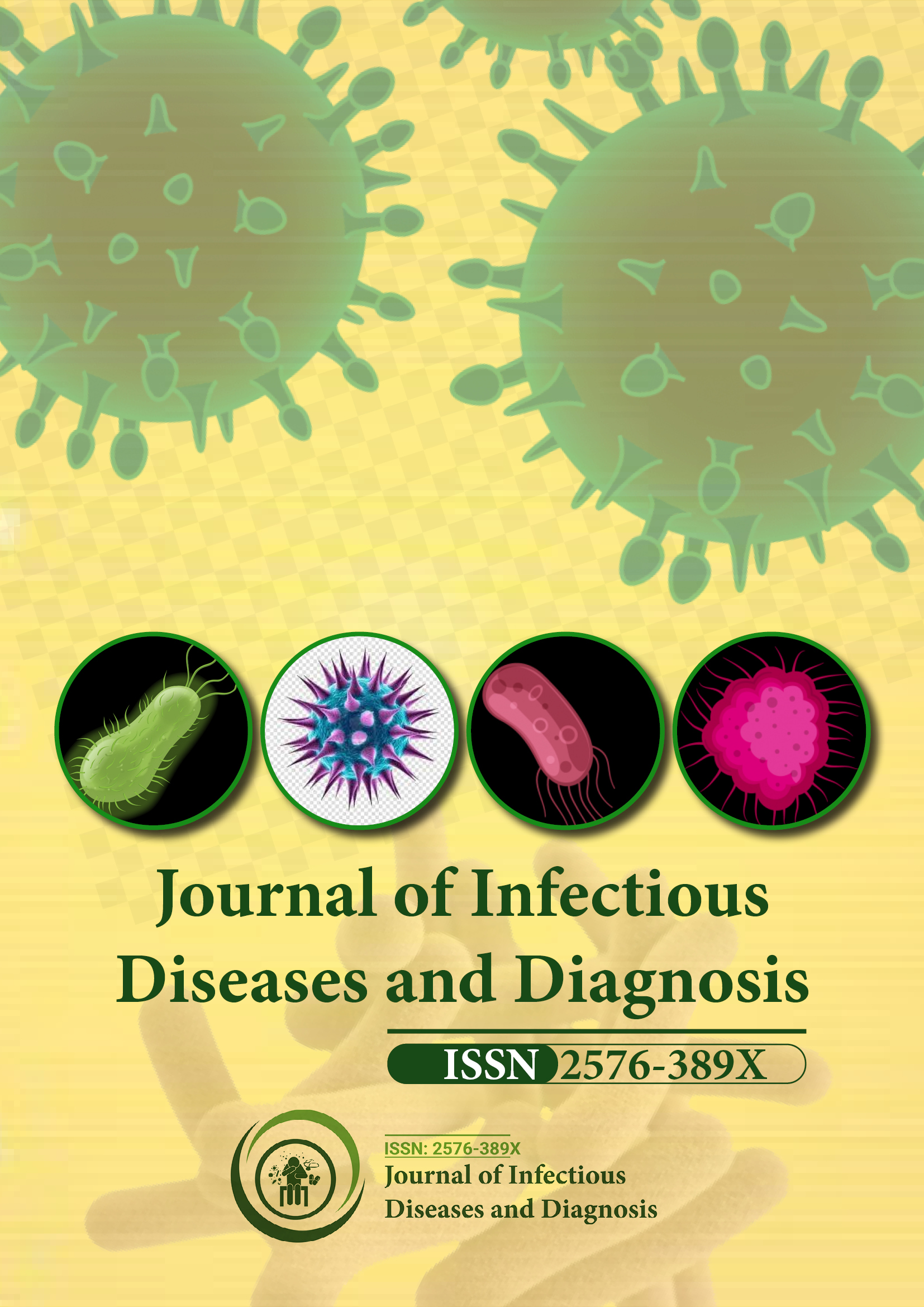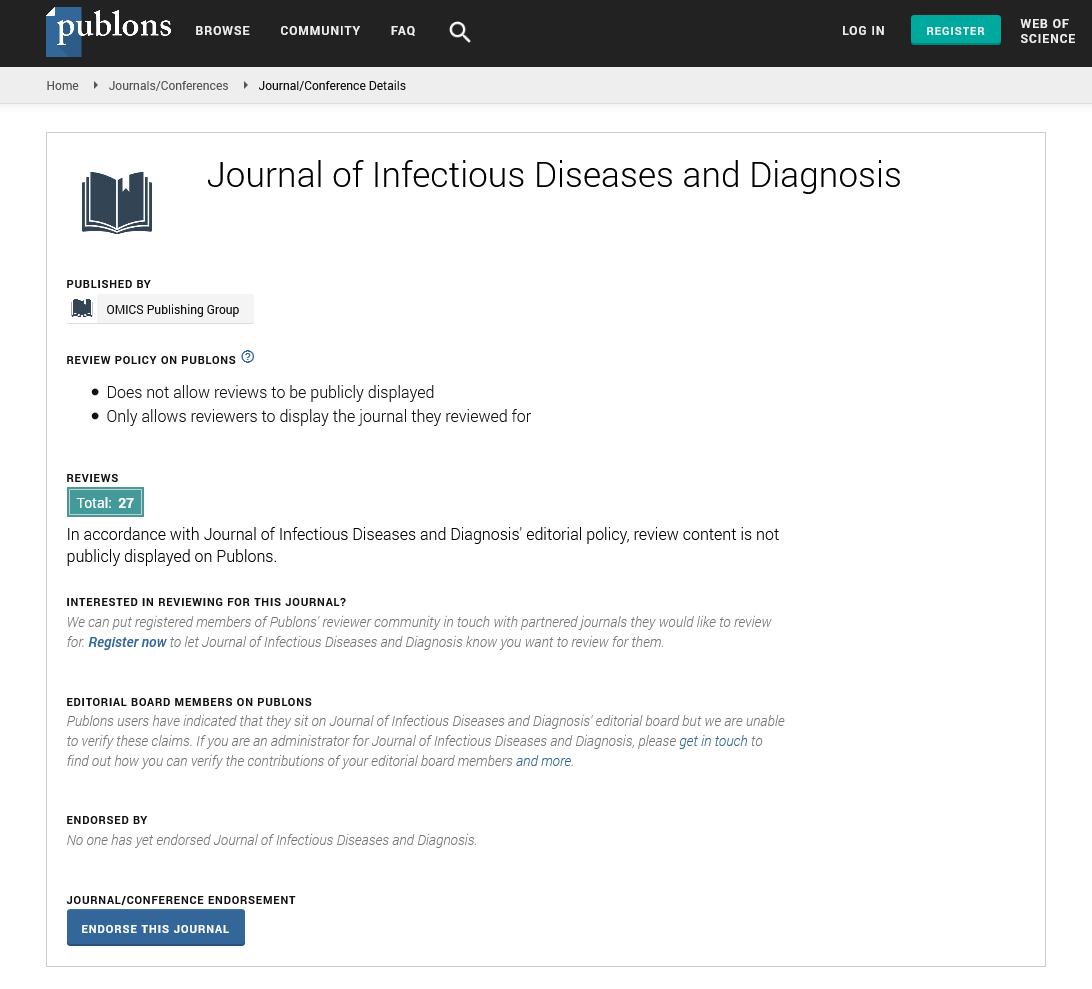Indexed In
- RefSeek
- Hamdard University
- EBSCO A-Z
- Publons
- Euro Pub
- Google Scholar
Useful Links
Share This Page
Journal Flyer

Open Access Journals
- Agri and Aquaculture
- Biochemistry
- Bioinformatics & Systems Biology
- Business & Management
- Chemistry
- Clinical Sciences
- Engineering
- Food & Nutrition
- General Science
- Genetics & Molecular Biology
- Immunology & Microbiology
- Medical Sciences
- Neuroscience & Psychology
- Nursing & Health Care
- Pharmaceutical Sciences
Commentary - (2024) Volume 9, Issue 5
Assessment of Artificial Intelligence Algorithms for Predicting Disease Outbreaks from Diagnostic Data
Daniel Richardson*Received: 26-Aug-2024, Manuscript No. JIDD-24-26943; Editor assigned: 29-Aug-2024, Pre QC No. JIDD-24-26943 (PQ); Reviewed: 13-Sep-2024, QC No. JIDD-24-26943; Revised: 20-Sep-2024, Manuscript No. JIDD-24-26943 (R); Published: 27-Sep-2024, DOI: 10.35248/2576-389X.24.09.289
Description
The increasing prevalence of infectious diseases poses a significant challenge to global health systems. Early detection and prediction of disease outbreaks are important for effective intervention and containment. Traditional methods of monitoring and forecasting disease spread often fall short due to the complexity and volume of data involved. In recent years, artificial intelligence has emerged as a transformative tool in various fields, including epidemiology. By using advanced machine learning algorithms and big data analytics, AI can potentially enhance the accuracy and timeliness of disease outbreak predictions. This assessment aims to evaluate the efficacy of AI algorithms in predicting disease outbreaks based on diagnostic data. It will explore how different AI models process and analyze diagnostic data, their predictive accuracy and their practical applications in public health.
Artificial intelligence algorithms have emerged as powerful tools for predicting disease outbreaks, offering significant advancements over traditional methods. These algorithms, particularly those based on machine learning and deep learning, analyze vast amounts of diagnostic data to identify patterns and trends that might indicate an impending outbreak. Machine learning models, such as decision trees, support vector machines and ensemble methods, process structured data like laboratory test results, electronic health records and clinical diagnostic reports. These models learn from historical data to recognize signs of disease spread, using features such as symptoms, patient demographics and geographic location to make predictions. On the other hand, deep learning techniques, including neural networks and recurrent neural networks, excel in capturing complex, non-linear relationships within large datasets. These models are particularly adept at analyzing temporal and spatial data, enabling them to detect subtle patterns and shifts in disease dynamics that might elude simpler models.
In addition to structured diagnostic data, supplementary information such as environmental conditions (e.g., weather patterns, air quality) and behavioral data (e.g., travel habits, population density) are incorporated to enhance the predictive power of AI models. For instance, incorporating weather data can help predict seasonal outbreaks of diseases, while travel data can identify potential spread routes. Natural language processing algorithms also play an important role by processing unstructured data, such as clinical notes, social media posts and news articles, to extract relevant information and provide early warning signals of potential outbreaks.
The effectiveness of these AI algorithms is evaluated using several metrics. Accuracy measures the overall correctness of the predictions, while precision and recall assess the model’s ability to correctly identify true outbreaks and minimize false positives and negatives. The F1 score combines precision and recall to provide a balanced view of model performance. Additionally, the area under the receiver operating characteristic curve evaluates how well the model distinguishes between outbreak and non-outbreak conditions across various thresholds. Practical applications of AI in disease prediction are profound. Early warning systems that integrate AI algorithms can issue timely alerts for potential outbreaks, allowing for prompt public health responses and resource allocation. By predicting where and when an outbreak is likely to occur, these systems help in planning and deploying resources more effectively, thus reducing the impact of diseases. Furthermore, insights gained from AI-driven predictions can inform public health policies and strategies, guiding decisions on vaccination campaigns, quarantine measures and other interventions.
Despite their promise, AI algorithms face several challenges. Data quality and completeness are critical issues; inaccurate or incomplete data can lead to erroneous predictions. Additionally, the complexity of some models can make them difficult to interpret, posing challenges for stakeholders who need to understand and act on predictions. Ethical considerations and data privacy concerns also need to be addressed, ensuring that AI applications in public health are used responsibly and transparently. To fully realize the potential of AI in disease outbreak prediction, future research should focus on improving algorithmic accuracy, integrating diverse and high-quality data sources and enhancing the interpretability of models. Collaboration among data scientists, epidemiologists and public health professionals will be essential for developing strong, actionable AI solutions that can significantly improve our ability to predict and manage disease outbreaks.
Conclusion
The assessment reveals that AI algorithms hold significant promise for predicting disease outbreaks from diagnostic data. Machine learning and deep learning models, when trained on comprehensive and high-quality datasets, can identify patterns indicative of emerging outbreaks with high accuracy. The integration of supplementary data further enhances the strength of these predictions. Despite their potential, AI algorithms face challenges such as data quality issues, model interpretability and the need for substantial computational resources. Additionally, ethical considerations and data privacy concerns must be addressed to ensure responsible AI use in public health. To improve the effectiveness of AI in disease outbreak prediction, future research should focus on developing more sophisticated algorithms, incorporating diverse data sources and enhancing model transparency. Collaboration between data scientists, epidemiologists and public health officials will be important for translating AI predictions into actionable strategies. AI represents a valuable tool in the arsenal against infectious diseases. By continuously refining algorithms and leveraging emerging technologies, we can enhance our ability to anticipate and mitigate the impact of disease outbreaks, ultimately safeguarding public health and improving global disease response efforts.
Citation: Richardson D (2024). Assessment of Artificial Intelligence Algorithms for Predicting Disease Outbreaks from Diagnostic Data. J Infect Dis Diagn. 9:289.
Copyright: © 2024 Richardson D. This is an open-access article distributed under the terms of the Creative Commons Attribution License, which permits unrestricted use, distribution, and reproduction in any medium, provided the original author and source are credited.

